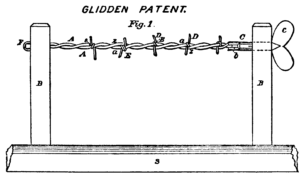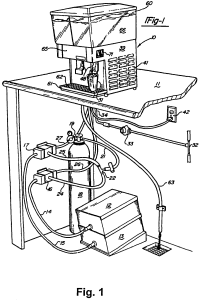by Dennis Crouch
In its petition for en banc rehearing Innovation Sciences raises some excellent outdated circumstances. En banc petition from Innovation Scis., LLC v. Amazon.com, Inc., 842 Fed. Appx. 555 (Fed. Cir. 2021)(unpublished). In specific, the petition argues that the Federal Circuit’s determination in the case is opposite to the two:
- Washburn & Moen Mfg. Co. v. Beat ‘Em All Barbed-Wire Co., 143 U.S. 275 (1892) (aka, The Barbed Wire Patent Cases) and
- Juicy Whip, Inc. v. Orange Bang, Inc., 292 F.3d 728 (Fed. Cir. 2002) (Notice, this is Juicy Whip II. in Juicy Whip I, the courtroom turned down a rivalry that the invention lacked utility for the reason that of its stated intent of deceiving the general public. Juicy Whip, Inc. v. Orange Bang, Inc., 185 F.3d 364 (Fed.Cir.1999)).
Both equally of these scenarios relate to the sort of evidence offered to invalidate issued patents.

In The Barbed Wire Scenarios, the patent challengers had released oral testimony from 24 eye-witnesses who every single testified that they observed a prior artwork fence on screen a county reasonable in 1858, and together with at the very least a single man or woman of ability in the art (a blacksmith). But, the Supreme Courtroom identified the proof missing. The courtroom famous the “unsatisfactory character” of oral testimony “arising from the forgetfulness of witnesses, their legal responsibility to issues, their proneness to recollect things” in a biased way.
The extremely simple fact, which courts as perfectly as the public have not unsuccessful to figure out, that almost every important patent, from the cotton gin of Whitney to the one under consideration, has been attacked by the testimony of witnesses who imagined they had produced related discoveries very long before the patentee had claimed to have invented his product, has tended to throw a selected quantity of discredit upon all that course of proof, and to need that it be subjected to the closest scrutiny. Thus, the Court docket confirmed really serious distaste for all oral testimony proffered to invalidate a patent–regardless of the curiosity of the witnesses.
Id. The courtroom verified this ruling in Eibel Method Co. v. Minnesota & Ontario Paper Co., 261 U.S. 45 (1923), crafting that:
[T]in this article is not a solitary prepared file, letter, or specification of prior date to Eibel’s software that discloses any such discovery by any a person, or the use of the pitch of the wire to aid the velocity of the mechine. The oral evidence on this point falls far limited of being more than enough to overcome the presumption of novelty from the granting of the patent. The temptation to recall in these types of situations and the ease with which sincere witnesses can persuade them selves right after a lot of years of possessing experienced a conception at the basis of a worthwhile patent, are properly known in this department of regulation, and have properly led to a rule that proof to demonstrate prior discovery should be obvious and satisfactory.
Id.

The beverage dispenser situation, Juicy Whip, follows along this same line, but also focuses on the use of non-prior artwork as evidence. In specific, the accused infringer had “recreated” what it claimed was a prior artwork beverage dispenser and presented oral testimony. The appellate court docket rejected the demonstration as “no far more dependable than any of the other oral testimony.” Id. A patent cannot be invalidated based upon “oral testimony accompanied by an admittedly non-anticipatory visual support.” Id. Juicy Whip was determined by the standard professional-patentee Judge Linn and joined by Choose Lourie. Decide Mayer wrote in dissent that the oral testimony coupled with the product should be ample.
The new petition relating to these difficulties is Innovation Scis., LLC v. Amazon.com, Inc., 842 Fed. Appx. 555 (Fed. Cir. 2021)(unpublished). The case entails some type of wi-fi communications engineering beneficial in household automation. The closest prior artwork was a household automation software program named HAL2000 designed by Tim Shriver back in the early 2000s. But, the patents really don’t just include program. Fairly, they are directed to many software program-components mixtures and approaches of use of those mixtures.
In buy to demonstrate the use of HAL2000 fulfilled all the restrictions, Amazon experienced Shriver apply the outdated code on some aged components. Then, Amazon’s qualified witness tested the new development that we may well contact HAL2019 to exhibit that the prior art satisfied all the claim restrictions. After listening to these benefits, the jury sided with the defense and observed the claims invalid as anticipated. On enchantment, the Federal Circuit affirmed. Whilst it was a non-precedential view, the court docket was somewhat careful to clarify that the recreation was suitable in this circumstance because “substantial proof supports a getting that the HAL procedure on which Dr. Johnson primarily based his opinion was agent of prior-art HAL techniques.” Innovation Scis. 842 Fed. Appx. 555.
The petition clarifies the hardware and configuration for prior artwork HAL systems had been each individual uniquely put in by consumers and that the unique recreated HAL process was developed in 2019 making use of the asserted promises as a roadmap relatively than in fact recreating anything known to exist. And, in accordance to petitioner, this recreated system “was the only prior artwork relied upon at trial.” (with 1 insignificant exception). Though no one testified that the 2019 method as produced really existed ahead of the vital date, folks did testify that the 2019 program “could have” existed. Centered upon these recitations of the evidence, the petition then asks two thoughts:
- Whether it is correct to take care of a program built in 2019 for functions of the litigation that bundled specific prior artwork parts (i.e., the 2019 HAL Procedure) as an anticipatory reference in the absence of evidence that 2019 method in fact existed prior to the 2006 vital date and
- Whether or not the recommendation that a prior artwork technique could have existed right before the important date can meet up with the clear and convincing proof normal essential to verify invalidity.
I see the issues right here as fabulously fascinating and crucial. The realistic trouble for the petitioner although stems from the legislation that appears keen to permit recreations of the prior artwork so long as ample documentary proof supports a summary that the recreation is consultant of the prior art. And, in this scenario, the challenger offered a wide range of evidence to verify that place, such as item manuals, articles, and even a video of the program remaining shown on Oprah. Regardless of citing these great instances, in the stop, the Plaintiff is genuinely arguing that individuals bits of evidence are inadequate. And, re-arguing the information is nearly normally a dropping proposition for rehearing.
= = =
Chief Decide Moore authored the Federal Circuit belief joined by Judges Prost and Hughes. Donald Jackson and his group at Davidson Berquist represented the patentee at demo, on enchantment, and in this petition for rehearing. Amazon relied on David Hadden and his staff from Fenwick all through the circumstance. The Federal Circuit’s appellate method bars any opposing response unless requested by the court docket.






More Stories
This Is What “It’s On Sight” Mean
World Cup 2022 closing ceremony set to be ‘A Night To Remember’ | Qatar World Cup 2022 News
Innovating the practice of law in Asia: An interview with Jonathan Voo – Asia Law Portal